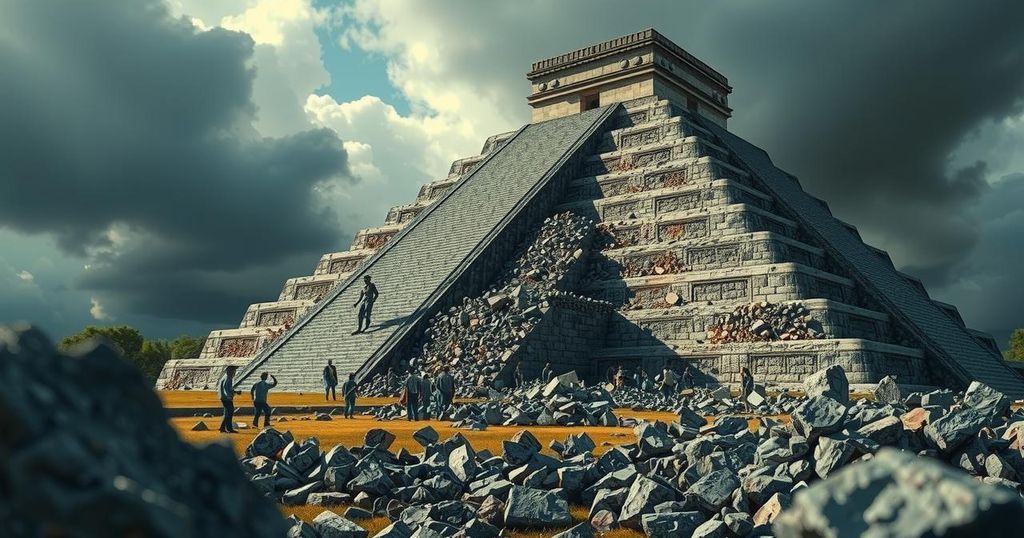Pyramid Collapse in Mexico Highlights Climate Change Threats to Heritage Sites

In July 2024, a historic pyramid in Michoacán, Mexico, collapsed due to extreme weather conditions exacerbated by climate change, marking an urgent reminder of the vulnerabilities faced by cultural heritage sites. The event highlights the need for increased efforts to protect these precious monuments and emphasizes the significant impacts of climatic changes on ancient civilizations and their legacies.
In a tragic incident reflective of the climatic upheaval currently affecting global heritage sites, a notable pyramid in Michoacán, Mexico, collapsed following intense rainfall on July 29, 2024. This noteworthy structure, approximately 15 meters tall, succumbed to inundation and disrepair, losing its southern wall to a pile of rubble. Once celebrated as one of the finest monuments of the ancient Michoacán Kingdom, its downfall signals broader implications for historical preservation amid severe climate conditions. The archaeological site of Ihuatzio, the location of this pyramid, serves as a testament to the ancient Nahuatl-speaking civilizations, and later the P’urhépecha people, who established an enduring culture impervious to Aztec conquest. Unfortunately, damage was not limited to the lone pyramid that collapsed; experts from Mexico’s National Institute of Anthropology and History (INAH) reported the deterioration of at least six other structural components at the site, influenced by the recent severe weather patterns. The summer of 2024 has brought unprecedented challenges to Mexico, with heavy rains following a historically severe drought that drained several lakes, leading to structural vulnerabilities within ancient edifices. According to INAH, “The high temperatures, previously recorded in the area, and the consequent drought caused cracks that favored the filtration of water into the interior of the pre-Hispanic building”. Amid these climate-induced challenges, archaeologists face dual responsibilities: studying ancient human behavior while responding to contemporary climate impacts on cultural heritage. Reports have emerged globally concerning the deterioration of significant heritage due to environmental changes. Tariakuiri Alvarez, a member of the P’urhépecha tribe, articulated the emotional and cultural significance of the event, stating that the pyramid’s collapse is regarded as a “bad omen”. He recounted that such an occurrence symbolized divine displeasure among his ancestors. Furthermore, just prior to this incident, Utah’s renowned ‘Double Arch’ was similarly compromised, underscoring the urgency of this situation. As we witness the slow degradation of our intangible cultural treasures, the imperative to safeguard these sites for future generations becomes increasingly dire. The climate crisis is not merely an environmental issue—it also presents profound consequences for the preservation of our shared human legacy.
The collapse of the Michoacán pyramid serves as a poignant reminder of the impacts of climate change on global cultural heritage. In recent years, extreme weather events have accelerated the deterioration of historically significant sites, revealing vulnerabilities exacerbated by anthropogenic climate alterations. Furthermore, the cultural context of ancient civilizations highlights the deep-rooted connections between heritage preservation and contemporary environmental stewardship. The resilience of these heritage sites, which has persisted for centuries, now faces unprecedented threats that must be addressed with urgency and care.
The recent collapse of the pyramid at Ihuatzio reflects a critical intersection of cultural heritage and environmental stewardship amidst a changing climate. The targeted efforts to repair and protect such sites underscore the importance of preserving our collective history against the backdrop of climate-induced extremes. Ongoing dialogues surrounding these issues highlight the necessity for increased awareness and action as we strive to protect our planet’s historical landmarks for future generations.
Original Source: www.sciencealert.com








